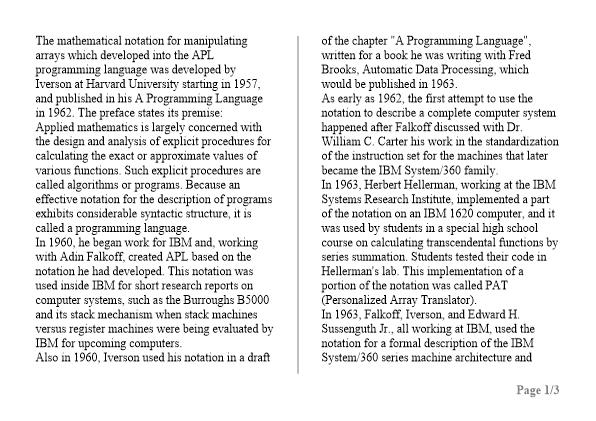| Automated charting and reporting |
SharpPlot Tutorials
General Tutorials
Chart Samples
Style Examples
Text Flow Tutorials
Table Tutorials
Visual Glossaries
SharpPlot Reference
SharpPlot Class
SharpPlot Properties
SharpPlot Methods
SharpPlot Structures
SharpPlot Enumerations
PageMap Class
SharpLeaf Reference
SharpLeaf Class
SharpLeaf Properties
SharpLeaf Methods
Table Class
Table Properties
Table Methods
SharpLeaf Structures
FontType Structure
ParagraphStyle Structure
BoxStyle Structure
SharpLeaf Enumerations
DocumentLayout Classes
DocumentLayout Class
PageLayout Class
PageElement Abstract Class
Frame : PageElement Class
TextBlock : PageElement Class
ImageBlock : PageElement Class
Box : PageElement Class
Rule : PageElement Class
Common Reference
Document Class
VectorMath Class
DbUtil Class
Download
Release Notes
Licensing
SharpLeaf Tutorials > Document Layout Tutorials > Advanced DocumentLayouts
Advanced DocumentLayouts
Examples of multi-frame and multi-page document layouts.
Using two frames per page
paper = PaperSize.Landscape(PaperSize.A5); left = 36; right = -36; top = 36; bottom = -48; // Leave more room at bottom for footer center = 0.5 * paper[0]; cl = center - 24; cr = center + 24; // gap around center leftframe = new Frame("LeftFrame",left,top,cl,bottom); // Left-hand frame rightframe = new Frame("RightFrame",cr,top,right,bottom); // Right-hand frame rule = new Rule(center,top,center,bottom,1,Color.Gray); // Rule between frames footfont = new FontType("Times",12,FontStyle.Bold,Color.Gray); // Footer font // Page footer with page count, 12 point below bottom footer = new TextBlock("Page {page}/{pages}",footfont,left,bottom + 12,right,bottom + 12,Alignment.Center,VerticalAlignment.Top,false); page = new PageLayout(paper); // Page frames are taken in the order in which they are added page.Add(new PageElement[] {leftframe,rightframe,rule,footer}); // Take a deep copy as of now to ignore further changes to page and its children layout = new DocumentLayout(page.Clone()); lf = new SharpLeaf(layout); lf.AddParagraphs(aplparas);


Using alternate page definitions
// Let's modify the footer alignment to alternate between left and right pages footer.Alignment = Alignment.Left; leftpage = page.Clone(); // Modify page and freeze footer.Alignment = Alignment.Right; rightpage = page.Clone(); // Modify page and freeze // Use alternating page definitions, starting with a right page layout=new DocumentLayout(new PageLayout[] {rightpage,leftpage}); lf = new SharpLeaf(layout); lf.AddParagraphs(aplparas);


Adding special element to first page
sender = "John Smallcroft\n9256, Downside Close\nButthillbury\nLostshire NW82 "+
"9ZP\nUnited Kingdom";
recipient = "Bernard Petitgruet\n137, Impasse des oubliettes\n98350 St-Trou-lès-Oies\nFrance";
// Let's modify our page to make the first page layout with addresses and a logo
// Put a logo on top-left corner
page.Add(new ImageBlock("dyalog.jpg","dyalog.jpg",left,top,72,72));
addressfont = new FontType(); // Default font
// Sender address (fixed) on top-right corner with no wrapping
page.Add(new TextBlock(sender,addressfont,right,top,right,top,Alignment.Right,
VerticalAlignment.Top,false));
// Recipient address - Frame to be flowed without clip nor skip, so that text
// overflows if necessary
page.Add(new Frame("Recipient",left,144,right,200,false,false,false));
// First page is a right page - remember we have touched it earlier
footer.Alignment = Alignment.Right;
top = 230;
// Bring frames and rule down to leave space for addresses
leftframe.SetCoordinates(left,top,cl,bottom);
rightframe.SetCoordinates(cr,top,right,bottom);
rule.SetCoordinates(center,top,center,bottom);
// Need to be explicit about Frame order because Recipient was added after the others
page.FrameList = new string[]{"Recipient","LeftFrame","RightFrame"};
firstpage = page.Clone(); // Take deep copy of our new page definition
// Remember that the first page is a right page
layout=new DocumentLayout(new PageLayout[] {firstpage,leftpage,rightpage});
layout.Repeat = 2; // Repeat only the last two pages of the layout
lf = new SharpLeaf(layout);
lf.AddParagraphs(recipient);
lf.NextFrame();
lf.AddParagraphs(aplparas);

